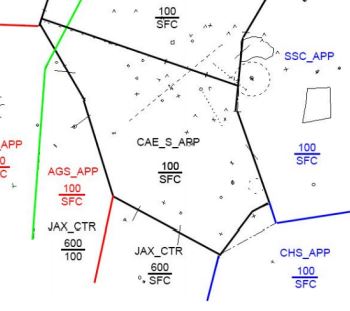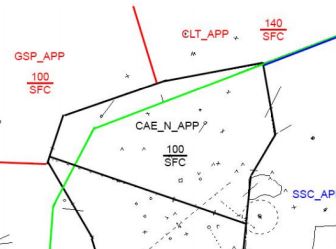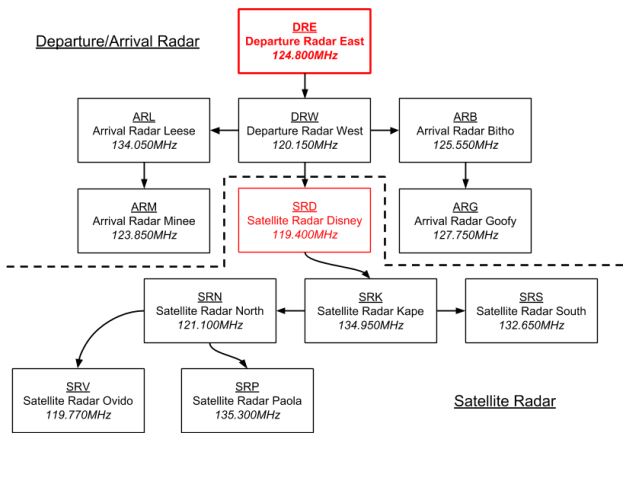F11 SOP: Difference between revisions
| Line 119: | Line 119: | ||
== [[Sectorization Flow Chart]] == | == [[Sectorization Flow Chart]] == | ||
[[File:F11Flow.JPG]]<br><br> | [[File:F11Flow.JPG]]<br><br> | ||
Description: | <b>Description:</b><br> | ||
1. The primary “combined” radar position shall be DRE. No other sectors shall be staffed until the “combined” position is already in use.<br> | 1. The primary “combined” radar position shall be DRE. No other sectors shall be staffed until the “combined” position is already in use.<br> | ||
2. Once DRE is in use, DRE may delegate a portion of its airspace to DRW. Thereafter, DRW may delegate a portion of its airspace to ARB.<br> | 2. Once DRE is in use, DRE may delegate a portion of its airspace to DRW. Thereafter, DRW may delegate a portion of its airspace to ARB.<br> | ||
Revision as of 14:05, 10 February 2023
Area Information
| ICAO Code | Airport Name | Airspace | IFR Beacon Codes | VFR Beacon Codes |
|---|---|---|---|---|
| F11 | Central Florida Tracon |
Purpose:
This document prescribes the procedures to be utilized for providing air traffic control services at the Central Florida Tracon. The procedures described herein are supplemental to the Jacksonville ARTCC Facility Operating Guidelines and FAA Order JO 7110.65, as well as any published FAA guidelines or procedures.
Distribution:
This order is distributed to all Jacksonville ARTCC personnel.
Operational Positions
| Position | Sector Name | Callsign | Relief Callsign | Symbol | Frequency |
|---|---|---|---|---|---|
| DRE | Departure Radar East | MCO_E_APP | MCO_1E_APP | 4E | 124.800 |
| DRW | Departure Radar West | MCO_W_APP | MCO_1W_APP | 4W | 120.150 |
| ARB | Arrival Radar Bitho | MCO_B_APP | MCO_1B_APP | 4B | 128.375 |
| ARL | Arrival Radar Leese | MCO_L_APP | MCO_1L_APP | 4L | 134.050 |
| ARG | Arrival Radar Goofy | MCO_G_APP | MCO_1G_APP | 4G | 127.750 |
| ARM | Arrival Radar Minee | MCO_M_APP | MCO_1M_APP | 4M | 123.850 |
| SRD | Satellite Radar Disney | MCO_D_APP | MCO_1D_APP | 4D | 119.400 |
| SRK | Satellite Radar Kape | MCO_K_APP | MCO_1K_APP | 4K | 134.950 |
| SRN | Satellite Radar North | MCO_N_APP | MCO_1N_APP | 4N | 121.100 |
| SRS | Satellite Radar South | MCO_S_APP | MCO_1S_APP | 4S | 132.650 |
| SRV | Satellite Radar Ovido | MCO_V_APP | MCO_4V_APP | 4V | 119.775 |
| SRP | Satellite Radar Paola | MCO_P_APP | MCO_1P_APP | 4P | 135.300 |
Sector in Red is the primary sector.
Sectorization Flow Chart
Description:
1. The primary “combined” radar position shall be DRE. No other sectors shall be staffed until the “combined” position is already in use.
2. Once DRE is in use, DRE may delegate a portion of its airspace to DRW. Thereafter, DRW may delegate a portion of its airspace to ARB.
3. Once ARB is in use, ARB may delegate a portion of its airspace to ARL. Thereafter, ARL may delegate a portion of its airspace to ARM.
4. Once ARM is in use, ARM may delegate a portion of its airspace to ARG. ARM/ARG are considered “final” radar positions and of the two ARM shall be opened first.
5. Once DRW is in use, DRW may delegate a portion of its airspace to SRD. Thereafter, SRD may delegate a portion of its airspace to SRK.
6. Once SRK is in use, SRK may delegate a portion of its airspace to SRS or SRN. Thereafter, SRN may delegate a portion of its airspace to SRV and SRP. SRV is dependent on SRN and therefore, SRV shall NOT be opened unless SRN is already in use. SRN assumes responsibility for SRV airspace when SRV is not in use.
NOTE: SRP is intended to be a “final” radar position for the SFB Airport and should only be used during high-volume traffic scenarios.
TRACON Information
Sectorization Description
The primary “combined” radar position shall be RS. No other sectors shall be staffed until the “combined” position is already in use.
Once RS is in use, RS may delegate a portion of its airspace to RN.
Unless otherwise coordinated, RS and RN are responsible for areas depicted.
RS and RN provide overflight services and approach sequence to aircraft landing in the Columbia ATCT airspace.
VFR Aircraft
VFR Aircraft entering the Class Charlie airspace will be given a discrete beacon code.
If an aircraft departs from CAE and does not request a flight following, the aircraft will be handed off from LC to TRACON and released to UNICOM once clear of the Class Charlie.
Handoff and Radar Tracking
Columbia ATCT is a VFR tower. No radar handoffs shall be initiated to LC.
TRACON controllers shall not drop track on any arriving aircraft. This allows a controller to maintain radar identification during missed approach.
Release and Rolling Calls
TRACON sectors give automatic releases to all departures from Columbia ATCT when departures follow the standard departure procedures as specified in this document.
All other airports within TRACON’s boundaries shall request a departure release. Upon approval of the release, the release shall be good for five minutes.
Upon issuance of the takeoff clearance, a departure message shall be sent to the appropriate departure sector. This can be accomplished non-verbally by the LC ensuring the aircraft is squawking the appropriate squawk code and mode C is enabled when airborne.
TRACON Departure Procedures
Forward departure instructions to LC for aircraft executing practice missed approaches.
Ensure all departures are on course as soon as practical.
All departures should be on course before handoff to Enroute Control unless otherwise coordinated. Aircraft shall be climbed to 10,000 or less if filed.
Provide airspace for automatic departures and radar final.
Provide airspace for missed approach on all runways.
TRACON Arrival Procedures
The sector responsible for the primary runway shall establish the approach sequence for all arrivals.
Communications transfer of arriving aircraft to LC must be accomplished no later than five nautical miles from the end of the arrival runway.
When simultaneous approaches are being conducted on converging runways, LC is responsible for ensuring runway separation. However, TRACON must provide enough spacing to minimize the possibility of a go-around.
When vectoring to final from parallel downwinds, aircraft on opposing base legs shall be assigned altitudes to ensure vertical separation unless other approved separation has been applied. This ensures separation in the event of an overshoot on final.
Coordinate with LC for any aircraft conducting approaches to other runways than the active arrival runway(s) in use.
Responsibility
RS area of jurisdiction is the South quadrant of the airspace as depicted, surface to 10,000 feet MSL.
RS is responsible for departure control for Southbound traffic.

Responsibility
RN area of jurisdiction is the North quadrant of the airspace as depicted surface to 10,000 feet MSL.
RN is responsible for departure control for Northbound traffic.

Responsibility
RN and RS may delegate a portion of their airspaces to RF, once both are in use.
RF area of jurisdiction is from the arrival end of the selected arrival runway to a 20nm radius for 10nm on either side of the selected arrival runway, from surface to 4,000 feet MSL. RF is responsible for sequencing arrival aircraft.
